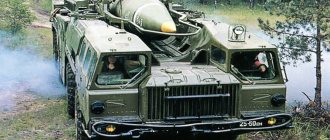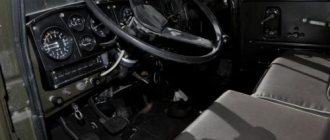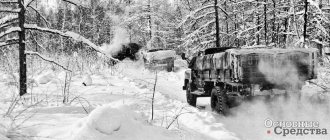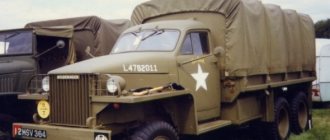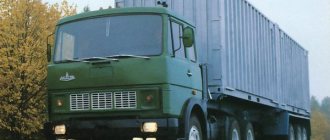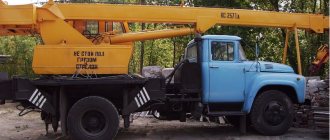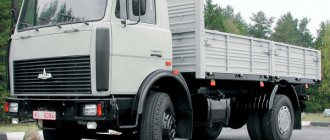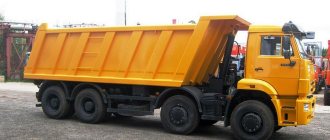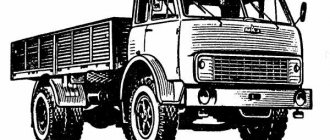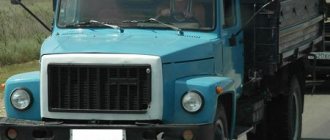Pavel Gamankov, photo by the author
When Europe introduced strict requirements for trucks on local roads, the Minsk Automobile Plant had to modify the design of its vehicles. The main changes affected the location of the front light fixtures. After such a facelift, the cabover trucks of the MAZ-5335 family met strict European requirements and were able to move freely along the roads of the Old World. Today it’s hard to believe, but in 1977, serial Belarusian cars actually met all European standards.
Origins
Today, the vast majority of heavy MAZ trucks have a cabover design. Cars with a cab over the engine have a number of obvious advantages compared to “bonnet” ones. For example, rational use of chassis length, better maneuverability, visibility, etc. But in 1958, when Minsk began developing a cabover truck, all these advantages did not look so convincing. The decision to design the first truck of our own design (and even with a cab over the engine) was extremely ambitious and for a long time had many opponents.
At the end of 1958, the first prototypes of the MAZ-500 family were released, which had an incredibly long pre-production history. In 1959, the cars were sent for testing and fine-tuning. But even in 1962, after a huge number of modifications, the management of the Minsk Automobile Plant once again chose not to take risks. The release of the “500th” was postponed until better times, meanwhile increasing the pace of production of obsolete cars of the “200th” family. In the early 1960s, the experimental workshop of the plant produced 122 vehicles of two modifications - MAZ-500 and MAZ-503 (dump truck). All these cars were sent to different parts of the Soviet Union, where they were used in real conditions.
As a result, they decided to abandon the production of MAZ-200 bonneted trucks and move to full-scale production of vehicles of the “five hundredth” family in Minsk only in 1966. According to official information, the last “bonnet” rolled off the plant’s assembly line on December 31, 1965. The next day, the factory workers already began assembling the cabover cars. To be fair, it should be said that MAZs of the “200th” family rolled off the assembly line in 1966 (a large number of unused components remained in the plant’s warehouses), but that’s a completely different story.
The new cars were far from ideal and had many “childhood diseases”. Therefore, the cabovers were constantly refined and modernized. Four years after the launch of the series, the “500th” was updated. The onboard MAZ-500A has become a little narrower (2500 versus 2650 mm for the MAZ-500) to comply with European standards. But the vehicle’s carrying capacity increased by 1 ton (up to 8000 kg). These trucks remained on the assembly line until 1978, since the year before that the production of modernized MAZ-5335 vehicles began. This is where our story begins.
Modifications
The following modifications exist:
- 5335 – basic flatbed truck;
- 5334 – chassis without body;
- 53352 – wheelbase 5000 mm, load capacity 8.4 tons, YaMZ-238E engine and eight-speed gearbox;
- 516B – three axles (rear – lifting) and YaMZ-238N engine (300 hp);
- 5549 – dump truck;
- 5429 – truck tractor;
- 509A – timber carrier.
All versions were produced from 1977 to 1990. The exception is the MAZ-509A, the production of which began a year later than the others.
"Lobasty"
In front of us is a MAZ-5335 flatbed truck. As already mentioned, its main distinguishing feature from previous generation cars is the headlights located in the bumper. The direction indicators and side light bulbs, on the contrary, migrated upward to the level of the radiator grille. By the way, the shape of the latter has also undergone slight changes. Externally, it has become much wider due to the use of decorative plastic overlays - but the ventilation area has remained the same. The journey of optics did not end there. The side turn signal indicators were lowered lower to the wheel arches. On the MAZ-500A they were located at the level of the door handles. The taillights have not undergone significant changes.
A serious improvement was the use of a body with metal sides instead of wooden ones on the MAZ-500A. True, the quality of the paint, and even the metal itself, left much to be desired - the bodies rusted literally after the first winter. In this sense, wooden superstructures were much better. But it is easier to damage them during loading.
Under the body on the left in the direction of travel there was a box for batteries and a fuel tank with a capacity of 200 liters. On the right, in a horizontal position, a spare wheel is suspended on a folding bracket. Such mounting was not possible on truck tractors, so the “spare wheel” was placed behind the cab.
We have before us the most popular modification of a flatbed truck with a wheelbase of 3950 mm, but for long-haul transportation the MAZ-53352 model with a body of increased capacity was developed. The wheelbase of the “truck” was 5000 mm, and the fuel tank was increased to 320 liters.
Device
MAZ 5335 has a design similar to MAZ 550A. The front engine and rear-wheel drive increase the vehicle's maneuverability. The car is built on a 4 by 2 wheel design, but is equipped with extended front springs and modified telescopic shock absorbers. Due to this, vehicles without cargo confidently keep a straight lane when driving. Among other design discoveries is a modernized rear axle, made in such a way that by changing the number of teeth in the wheel gearboxes and the size of the tires, the gear ratio can be changed.
All modifications use a YaMZ-236 5-speed manual transmission with synchronizers in 2nd, 3rd, 4th and 5th gears and a 3-way circuit. The use of a dry 2-disc clutch in the transmission ensures smooth and precise gear shifting. The gear ratio of the main pair is 4.89. The main gear has planetary gearboxes in the wheel hubs. The speed selector lever is located on the floor to the right of the driver's seat. The new gearbox made it possible to increase the machine's service life to 320,000 km and reduce the labor intensity of maintenance.
MAZ 5335 turned out to be one of the first products of the Minsk Automobile Plant with a 2-circuit braking system, supplemented by separate drive along the axles. The innovation had a positive impact on traffic safety and made it possible to increase speed. The brake system was still based on drum mechanisms.
The design of the MAZ 5335 has been modified to meet international requirements. The headlights were installed in the bumper niches, which improved the illumination of the space in front of the car. Thanks to the new arrangement, there was no dazzling of oncoming drivers. The direction indicators have remained in the same place, and the radiator grille has been transformed, increasing in size.
The 3-seater cabin was quite spacious, although it provided a minimum of comfort. The seats were mounted on springs, compensating for vibrations that occur when driving over uneven surfaces. For the driver's seat, it was possible to adjust the distance to the front panel and adjust the angle of the backrest. Behind the chairs there was the possibility of equipping a sleeping place. Air conditioning was not installed in the MAZ 5335, so in hot weather the only salvation was opening the windows. The heater was listed as a basic version and was highly efficient. With it, the driver of the car was not afraid of even severe frosts. The presence of power steering simplified driving. The steering mechanism had its own 5 liter oil tank. During normal operation, lubricant was added once every 100,000 km.
The body of the MAZ 5335 has undergone major changes. A platform with metal sides was installed on the car (previously wooden sides were used). However, the poor quality of metal and paint led to rapid corrosion.
Dimensions:
- length – 7250 mm;
- width – 2500 mm;
- height – 2720 mm;
- wheelbase – 3950 mm;
- ground clearance - 270 mm;
- front track – 1970 mm;
- rear track – 1865 mm.
The vehicle weight is 14950 kg, maximum load capacity is 8000 kg. The machine is capable of working with trailers weighing up to 12,000 kg. The maximum speed of MAZ 5335 is 85 km/h.
Top class
The cabin of the new cabover has also undergone cultural changes. The interior has been improved and made more modern. For long-distance flights on which a couple of drivers worked, there are two comfortable seats with armrests, sprung and with backrests adjustable in angle. If previously only the driver had a comfortable workplace, now the partner also received his share of amenities. In the basic version, there is one sleeping place behind the seats. In addition, it was possible to order an additional hanging hammock for an overnight stay for the second driver. True, it can be a stretch to call it an overnight stay. A modern driver wouldn’t dream of such a dream together even in his worst nightmare, excuse the pun. It’s problematic for even one person to fit comfortably on the main “sleeping bag” - the width of the sleeping place is about 500 mm, and you can’t even stretch out to your full height. In general, sheer torture. And if you also have a partner hanging over you in a hammock, the pleasure is below average. It is generally better to remain silent about the sensations of those sleeping on the second tier. By the way, when equipping a second berth, it was recommended to remove the gearbox lever. Safety first! To be fair, it should be said that European trucks of those times also could not boast of cabs with two full-fledged berths.
The amount of bare iron in the cockpit was kept to a minimum. Even the front panel, with the exception of the instrument cluster, became plastic, which made the interior more comfortable. Even one “glove compartment” appeared. True, they placed it in such a way that you can’t reach it from the driver’s seat - at the right entrance door. And it was no larger in size than a modern small car, in which a passenger airbag was installed.
Drivers had a lot of complaints about the heating system of the “500th”, and in the new car the designers tried to correct the situation. Firstly, the driver could close the blinds in front of the radiator directly from the cab and, thus, the coolant (and most often water) would quickly reach operating temperature in the cold season. Secondly, the heating system deflectors were now directed not only to the windshield, but also to the driver’s feet. But this scheme only half solved the problem. In the literal sense of the word. The paradox is that the right leg of the MAZ-5335 driver was constantly warm, because warm air was blowing on it, but the left leg was still frozen, since the tightness of the truck doors was far from ideal. And since the warm air came from the central tunnel directed towards the feet, the passenger, on the contrary, could only warm his left leg.
By the way, some cars were already equipped with pre-start heaters, which not only made it easier to start the power unit in cold weather, but also contributed to the rapid heating of the coolant. Progress does not stand still.
Passport details
In addition to individual modifications and non-factory alterations, the technical characteristics of the base MAZ-5335 vehicle are as follows:
- The length of the vehicle is 7250 mm with a width of 2500 and a height of 2720. The maximum MAZ can transport 8 tons, reaching a speed of up to 85 km/h.
- A Yaroslavl V-shaped 12-valve diesel “six” YaMZ-236 is installed under the cabin. It had many modifications, but this particular one developed 180 hp. Paired with the engine is a “five-speed” gear (mechanical, of course), the lever of which is completely vertical in the cockpit.
Filling
The car that came to me for testing is equipped with one of the most common and popular Yaroslavl engines - YaMZ-236, a 12-valve V-shaped “six” develops a power of 180 hp. and provides a maximum torque of 667 N.m. Peak torque occurs at 1500 min-1, thanks to which the engine pulls well at the “lower” range, which is not typical for older diesel engines. But YaMZ-236 is popularly known for another, not the most positive, property. When developing the engine, the designers preferred the most favorable order of operation of the cylinders according to the scheme 1–4–2–5–3–6. This made it possible to achieve the highest efficiency, but such an algorithm entails high unevenness of torque and unbalance of the second-order moment of inertia forces. Therefore, the motor turned out to be very vibration-loaded even by the standards of the seventies. Resonant vibrations were transmitted to the cabin and controls. To solve this problem, the designers had to get tricky with attaching the power unit to the frame. A partial solution to the problem was to place the engine and gearbox on three mounts - two in the front and one in the tail.
For even greater comfort, front springs that were extended compared to the MAZ-500A and improved telescopic shock absorbers were used, which, among other things, made it possible to increase the maximum speed of the truck. The empty car stopped moving and easily kept a straight line while driving.
The five-speed (with overdrive V gear) Yaroslavl gearbox YaMZ-236P has a 3-way design and is equipped with synchronizers in II–III and IV–V gears. It is made according to a scheme in which the corresponding gears of all gears, except first and reverse, are in constant engagement with the gears of the primary and secondary shafts. By using a dry double-disc clutch in the transmission system, the designers were able to ensure smooth, clear shifts. All the described updates made it possible to increase the service life of the base MAZ-5335 vehicle to 320 thousand kilometers (a typical figure for European cars of the mid-1970s) and, among other things, reduced the labor intensity of maintenance. By the way, the warranty for trucks of the MAZ-5335 family was 12 months, provided that the mileage during this period did not exceed 30 thousand km, and the consumer complied with the rules of storage, operation and maintenance of the vehicle.
One of the interesting design findings is the new rear axle. It is designed in such a way that by changing only the tire size and the number of teeth in the wheel gearboxes, the developers could change the gear ratio. Thus, all modifications of the MAZ-5335, be it a tractor, flatbed truck or dump truck, used an identical rear axle. At the same time, gear ratios could be different depending on the specifics of the truck.
It only remains to add that in 1977, for the first time, a dual-circuit braking system with separate brake drive along the axles was used on Minsk trucks, which significantly improved the active safety of multi-ton trucks and again made it possible to increase the maximum speed of the vehicle.
Technical characteristics of the MAZ-5335 truck
| Overall dimensions (without awning), mm | 7250x2500x2720 |
| Wheel formula | 4x2 |
| Load capacity, kg | 8225 |
| Curb weight, kg | 6725 |
| Total weight, kg | 14 950 |
| Wheelbase, mm | 3950 |
| Ground clearance, mm | 270 |
| Engine: volume, cm3 maximum power, hp maximum torque, N.m | YaMZ-236 11 150 180 at 2100 min-1 667 at 1500 min-1 |
| Number of forward/reverse gears | 5/ 1 |
| Clutch | Double disc, dry |
| Fuel consumption in the combined cycle, l/100 km | 22 |
| Suspension front/rear | Spring |
| Brakes | Drum, pneumatic |
| Fuel tank volume, l | 200 |
Specifications
The MAZ 5335 clutch is a double-disc, dry, friction clutch with peripherally located coil springs. It had a very long resource and long service life. When adjusted correctly, the clutch allowed smooth shifting between gears without jerking or slipping. To extend the service life of the elements, you should not keep your foot on the clutch for a long time. This leads to rapid wear of the shift clutch bearings.
The MAZ 5335 gearbox is a five-speed manual with synchronizers in second through fifth gears. The gear ratio of the main pair is 4.89. Oil filling capacity – 9 liters. The main gear had planetary gearboxes in the wheel hubs. The shift lever was installed on the floor to the right of the driver. Switching between gears is effortless. The gearbox feels good, so the likelihood of accidentally switching to the wrong gear is minimized.
The domestically produced YaMZ-236 engine was installed on MAZ 5335 trucks. It was a six-cylinder power unit with a V-shaped cylinder arrangement. Engine displacement is 11,150 cubic centimeters, power is 180 horsepower at a rotation speed of 210 rpm. Maximum torque is achieved at a rotation speed of 1500 rpm and is 667 N*m. The cylinder diameter is 130 millimeters, the piston stroke is 140 millimeters. Compression ratio - 16.5. The fuel used is diesel fuel.
The engine cooling system is liquid, with a tank capacity of 39 liters. The lubrication system has a tank capacity of 33 liters. The engine was characterized by high wear resistance and unpretentiousness to the quality of fuels and lubricants. A simple and understandable device made it possible to quickly carry out local repairs right on the road. Under normal operating conditions and timely maintenance, the power unit easily covered 350-400 thousand kilometers without major repairs. Many parts were unified with other MAZ trucks, so if necessary, finding the right spare part was not difficult.
The remaining technical characteristics of the MAZ 5335 are as follows: length - 7.25 meters, width - 2.5 meters, height - 2.72 meters, ground clearance - 270 millimeters, wheelbase - 3.95 meters, rear track - 1.865 meters, front track - 1.97 meters. The wheel formula of the car is 4x2. The truck reached a maximum speed of 85 km/h. Average fuel consumption in mixed mode was 22 liters per 100 kilometers. The volume of the fuel tank is 200 liters. The car had a curb weight of 6.725 tons and a gross weight of 14.95 tons. The drum-type brake system was equipped with pneumatic drives and acted on all wheels. The minimum turning diameter is 17 meters. The car was “shod” in 300 R508 tires and used 8.5V-20-3101012 wheels.
The carrying capacity of the MAZ 5335 was 8 tons. The car could also pull a trailer with a maximum weight of 12 tons. The truck was used to deliver various agricultural and industrial goods that were not afraid of transportation in the open air. In military affairs, MAZ was used to deliver personnel to training sites or conduct combat operations. Sometimes, to create normal conditions for personnel, through the efforts of military units or auto repair shops, the bodies were equipped with a canvas top. It made it possible to protect people from precipitation and strong side winds. Also, for convenience, benches for sitting were installed along the sides.
Despite the fact that serial production was discontinued almost 25 years ago, the MAZ 5335 is still successfully used for cargo transportation throughout the country. There are enough offers for the sale of this equipment on the secondary market. Price range: from 200 thousand to 1 million rubles. The cost is influenced by the year of manufacture, mileage, as well as additional conditions, for example, a major engine overhaul or additional accessories installed on the car.
Engine
The base for the MAZ 5335 series was the Yaroslavl diesel unit YaMZ 236 with direct fuel injection and liquid cooling. The 6-cylinder 12-valve engine has earned the title of one of the most successful Soviet engines. The V-shaped arrangement of the cylinders (in 2 rows at an angle of 90 degrees) provided a more rational layout and reduced engine weight. Another feature of the YaMZ 236 was its simplicity of design and high maintainability.
Characteristics of the YaMZ 236 unit:
- working volume – 11.15 l;
- rated power - 180 hp;
- maximum torque – 667 Nm;
- compression ratio – 16.5;
- average fuel consumption – 22 l/100 km;
- service life before major repairs – up to 400,000 km.
For some modifications of the MAZ 5335, other engines were used:
- YaMZ-238E is a V-shaped 8-cylinder engine with turbocharging and liquid cooling. Displacement – 14.86 l, power – 330 hp, maximum torque – 1274 Nm;
- YaMZ-238N is an 8-cylinder unit with a turbine, designed for installation on a special chassis. Displacement – 14.86 l, power – 300 hp, maximum torque – 1088 Nm.
The car was equipped with a 200 liter fuel tank.
From the 70s to the present day...
Today, you can talk for a long time and in detail about the shortcomings of the “big-headed” MAZs - noisy engine, stiff suspension, unfinished heating system, etc. But the fact remains undeniable that MAZ-5335 trucks for many years remained one of the most popular and widespread vehicles in the Soviet Union , worked in the conditions of the Far North and in hot deserts, drove both along ideal European roads and construction sites. Machines of the “500th” family have been rolling off the assembly line for almost 25 years and even now are quite common and continue to work. This means that the project to create a cabover truck can be considered a success.
EuroMAZ Cabover trucks of the MAZ-5335 family
When Europe introduced strict requirements for trucks on local roads, the Minsk Automobile Plant had to modify the design of its vehicles. The main changes affected the location of the front light fixtures. After such a facelift, the cabover trucks of the MAZ-5335 family met strict European requirements and were able to move freely along the roads of the Old World. Today it’s hard to believe, but in 1977, serial Belarusian cars actually met all European standards.
Car MAZ 5335
MAZ 5335 is a Soviet truck, the production of which was carried out at the Minsk Automobile Plant in the 1977-1990s.
The history of the model is closely connected with the Yaroslavl Motor Plant. It was its development that formed the basis of the MAZ 200, the production of which continued until 1957. This series was replaced by the legendary MAZ 500, which became the basis for a huge number of versions. At that time, most trucks were built according to the classical scheme: a motor, control system and cabin were installed on the frame, after which the body was mounted for the remaining space. To increase its volume it was necessary to lengthen the frame. However, changing conditions required different approaches. The new series used a different design, where the engine was located under the cab, which tilted forward if necessary. This arrangement made it possible to increase the load capacity by 2000 kg while maintaining the same frame length.
Serial production of the MAZ 500 began in 1965, after which the Minsk Automobile Plant repeatedly modernized the model. For several years, specialists have been preparing a new car taking into account the wishes of consumers. In 1977, an onboard version of the MAZ 5335 appeared. Externally, the car was practically no different from the MAZ 500A (modified version of the MAZ 500), but inside the changes were significant (separate brake system, new elements, increased operating comfort). To comply with European standards, the design had to be changed in the production version. The MAZ 5335 radiator grille became wider, the headlights were moved to the bumper, and the roof hatches were abandoned. The platform has become more reliable and durable, and an improved dashboard has appeared in the cabin.
Minor modifications to the model were carried out later. In 1988, the Minsk Automobile Plant opened production of a new generation of MAZ 5336 trucks, but the MAZ 5335 series remained on the assembly line until 1990.
